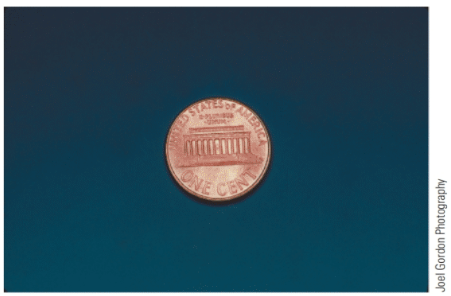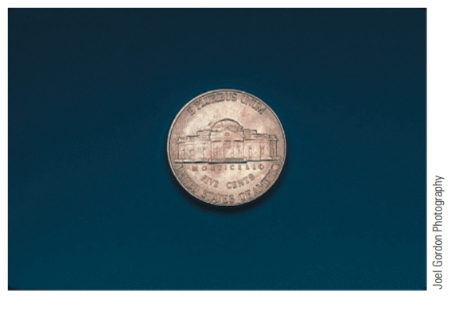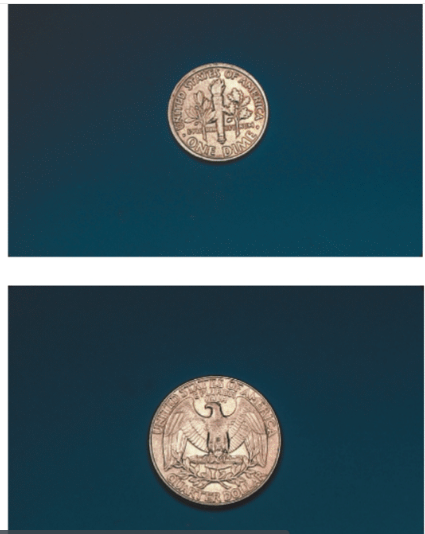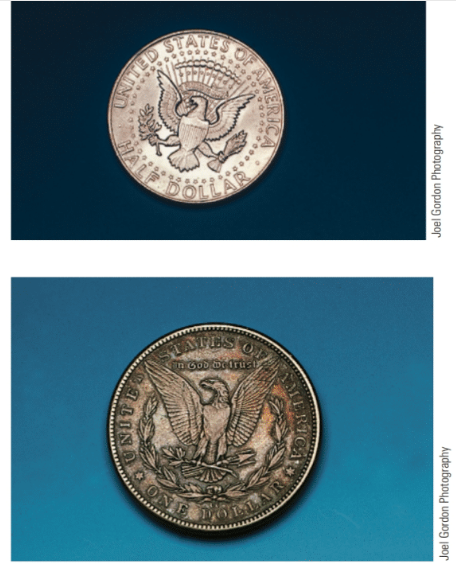
Chemistry In Focus
7th Edition
ISBN: 9781337670425
Author: Tro
Publisher: Cengage
expand_more
expand_more
format_list_bulleted
Concept explainers
Textbook Question
Chapter 2, Problem 53E
Each of the following coins is photographed to scale. Measure each using a metric ruler (in cm) and record the diameter to the precision reflected in the ruler. Make a simple graph of the value of the coin (x-axis) and the diameter of the coin (y-axis). Is there any correlation between these two quantities? Which coin does not fit the general trend?




Expert Solution & Answer
Trending nowThis is a popular solution!

Students have asked these similar questions
At 25°C, the reaction Zn2+ + 2e ⇄ Zn has a normal equilibrium potential versus the saturated calomel electrode of -1.0048 V. Determine the normal equilibrium potential of Zn versus the hydrogen electrode.Data: The calomel electrode potential is E° = 0.2420 V versus the normal hydrogen electrode.
Electrochemistry. State the difference between E and E0.
In an electrolytic cell, the positive pole is always assumed to be on the right side of the battery notation. Is that correct?
Chapter 2 Solutions
Chemistry In Focus
Ch. 2 - The volume of a liquid can be measured with a...Ch. 2 - Scientific Notation Express the number 0.0000023...Ch. 2 - Prob. 2SCCh. 2 - Prob. 3SCCh. 2 - Converting Between Units Convert 34.0 cm to...Ch. 2 - Prob. 2.3YTCh. 2 - Extracting Information from Graphical Data The...Ch. 2 - Solving Word Problems...Ch. 2 - Solving Word Problems Involving Units Raised to a...Ch. 2 - Prob. 2.7YT
Ch. 2 - Prob. 2.8YTCh. 2 - Without doing any calculations, determine whether...Ch. 2 - Prob. 1ECh. 2 - Prob. 2ECh. 2 - Prob. 3ECh. 2 - What is the difference between reporting the...Ch. 2 - Prob. 5ECh. 2 - Prob. 6ECh. 2 - Prob. 7ECh. 2 - Prob. 8ECh. 2 - Prob. 9ECh. 2 - What is a conversion factor? Give two examples of...Ch. 2 - Prob. 11ECh. 2 - Identify the decimal part, the exponential part,...Ch. 2 - What is density? Give two examples of possible...Ch. 2 - Since oil floats on water, what can you say about...Ch. 2 - Express each of the following in scientific...Ch. 2 - Express each of the following numbers in...Ch. 2 - Express each of the following in decimal notation:...Ch. 2 - Express each of the following in decimal notation:...Ch. 2 - The circumference of Earth at the equator is...Ch. 2 - The distance from New York to Los Angeles is 2777...Ch. 2 - A can of soda contains 12 fluid ounces. What is...Ch. 2 - A laboratory beaker can hold 150mL. How many fluid...Ch. 2 - A car has a fuel efficiency of 27 miles per...Ch. 2 - A European rental car can travel 17 km on a liter...Ch. 2 - Perform each of the following conversions within...Ch. 2 - Perform each of the following conversions within...Ch. 2 - Prob. 27ECh. 2 - Perform the following conversions between the...Ch. 2 - A pond has a surface area of 1552m2. Convert this...Ch. 2 - An orange has a volume of 54cm3. Convert this...Ch. 2 - Prob. 31ECh. 2 - Prob. 32ECh. 2 - A runner runs at a pace of 8.5 minutes per mile....Ch. 2 - A driver drives an average speed of 58 miles per...Ch. 2 - A sports utility vehicle gets 12 miles per gallon...Ch. 2 - A hybrid electric vehicle (HEV) is a car with both...Ch. 2 - The following graph shows the concentration of an...Ch. 2 - The following graph shows the historical...Ch. 2 - A 28.4-cm3 sample of titanium has a mass of...Ch. 2 - A 1.5-cm3 sample of silicon has a mass of 3.5 g....Ch. 2 - A 5.00-L sample of pure glycerol has a mass of...Ch. 2 - A 3.80-mL sample of mercury has a mass of 51.4g....Ch. 2 - Ethylene glycol (antifreeze) has a density of...Ch. 2 - A thief plans to steal a bar of gold from a womans...Ch. 2 - Prob. 45ECh. 2 - A proton has a radius of approximately 110-13 cm...Ch. 2 - What did Einstein mean when he said, The most...Ch. 2 - Prob. 48ECh. 2 - Prob. 49ECh. 2 - Prob. 50ECh. 2 - Prob. 51ECh. 2 - Consider each of the following balances. Which one...Ch. 2 - Each of the following coins is photographed to...Ch. 2 - Obtain an outdoor thermometer and record the...
Knowledge Booster
Learn more about
Need a deep-dive on the concept behind this application? Look no further. Learn more about this topic, chemistry and related others by exploring similar questions and additional content below.Similar questions
- In an electrolytic cell, the positive pole is always assumed to be on the right side of the battery. Is that correct?arrow_forwardCalculate the free energy of formation of 1 mol of Cu in cells where the electrolyte is 1 mol dm-3 Cu2+ in sulfate solution, pH 0. E° for the Cu2+/Cu pair in this medium is +142 mV versus ENH.Assume the anodic reaction is oxygen evolution.Data: EH2 = -0.059 pH (V) and EO2 = 1.230 - 0.059 pH (V); 2.3RT/F = 0.059 Varrow_forwardIf the normal potential for the Fe(III)/Fe(II) pair in acid at zero pH is 524 mV Hg/Hg2Cl2 . The potential of the saturated calomel reference electrode is +246 mV versus the NHE. Calculate E0 vs NHE.arrow_forward
- Given the galvanic cell whose scheme is: (-) Zn/Zn2+ ⋮⋮ Ag+/Ag (+). If we know the normal potentials E°(Zn2+/Zn) = -0.76V and E°(Ag+/Ag) = 0.799 V. Indicate the electrodes that are the anode and the cathode and calculate the E0battery.arrow_forwardIndicate the functions that salt bridges have in batteries.arrow_forwardIn the battery:Pt | H2 (g) | H+ (aq) | Fe2+ (aq) | FeIndicate the cathode and anode.arrow_forward
- Write the equations that occur when the electrode Pb (s) | PbI2 (s) | KI (ac) in a galvanic cell. a) It functions as a positive electrode b) It functions as a negative electrode c) What is the ion with respect to which this electrode is reversible?arrow_forwardState the formula to find the electromotive force of a battery as a function of the potential of the anode and the cathode.arrow_forwardWhy are normal electrode potentials also called relative electrode potentials?arrow_forward
- Easily differentiate between electrochemical potential and Galvani potential.arrow_forwardConstruct a molecular orbital diagram for carbon monoxide. Identify the relevant point group,include all of the appropriate symmetry labels and pictures, and fill in the electrons. Make sure toaccount for the difference in electronegativity between C and O. Hint: CO is substantiallyisoelectronic to N2. (PLEASE DRAW THE ENTIRE MO DIAGRAM!!!)arrow_forwardplease help with hwarrow_forward
arrow_back_ios
SEE MORE QUESTIONS
arrow_forward_ios
Recommended textbooks for you
 Chemistry & Chemical ReactivityChemistryISBN:9781337399074Author:John C. Kotz, Paul M. Treichel, John Townsend, David TreichelPublisher:Cengage Learning
Chemistry & Chemical ReactivityChemistryISBN:9781337399074Author:John C. Kotz, Paul M. Treichel, John Townsend, David TreichelPublisher:Cengage Learning Chemistry: Principles and PracticeChemistryISBN:9780534420123Author:Daniel L. Reger, Scott R. Goode, David W. Ball, Edward MercerPublisher:Cengage Learning
Chemistry: Principles and PracticeChemistryISBN:9780534420123Author:Daniel L. Reger, Scott R. Goode, David W. Ball, Edward MercerPublisher:Cengage Learning ChemistryChemistryISBN:9781305957404Author:Steven S. Zumdahl, Susan A. Zumdahl, Donald J. DeCostePublisher:Cengage Learning
ChemistryChemistryISBN:9781305957404Author:Steven S. Zumdahl, Susan A. Zumdahl, Donald J. DeCostePublisher:Cengage Learning
 Introductory Chemistry: An Active Learning Approa...ChemistryISBN:9781305079250Author:Mark S. Cracolice, Ed PetersPublisher:Cengage Learning
Introductory Chemistry: An Active Learning Approa...ChemistryISBN:9781305079250Author:Mark S. Cracolice, Ed PetersPublisher:Cengage Learning

Chemistry & Chemical Reactivity
Chemistry
ISBN:9781337399074
Author:John C. Kotz, Paul M. Treichel, John Townsend, David Treichel
Publisher:Cengage Learning

Chemistry: Principles and Practice
Chemistry
ISBN:9780534420123
Author:Daniel L. Reger, Scott R. Goode, David W. Ball, Edward Mercer
Publisher:Cengage Learning

Chemistry
Chemistry
ISBN:9781305957404
Author:Steven S. Zumdahl, Susan A. Zumdahl, Donald J. DeCoste
Publisher:Cengage Learning


Introductory Chemistry: An Active Learning Approa...
Chemistry
ISBN:9781305079250
Author:Mark S. Cracolice, Ed Peters
Publisher:Cengage Learning

Measurement and Significant Figures; Author: Professor Dave Explains;https://www.youtube.com/watch?v=Gn97hpEkTiM;License: Standard YouTube License, CC-BY
Trigonometry: Radians & Degrees (Section 3.2); Author: Math TV with Professor V;https://www.youtube.com/watch?v=U5a9e1J_V1Y;License: Standard YouTube License, CC-BY